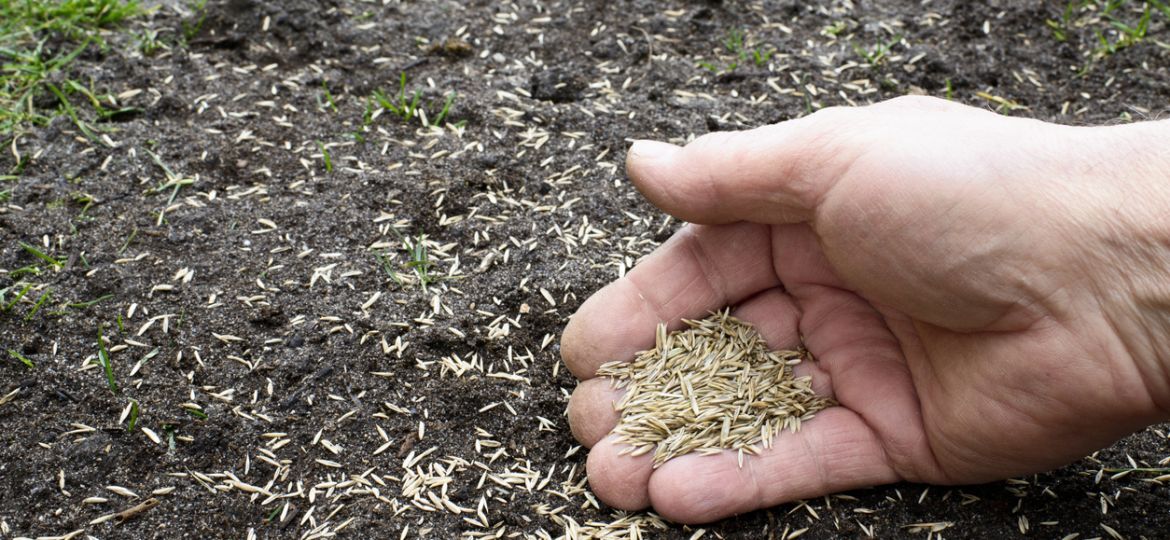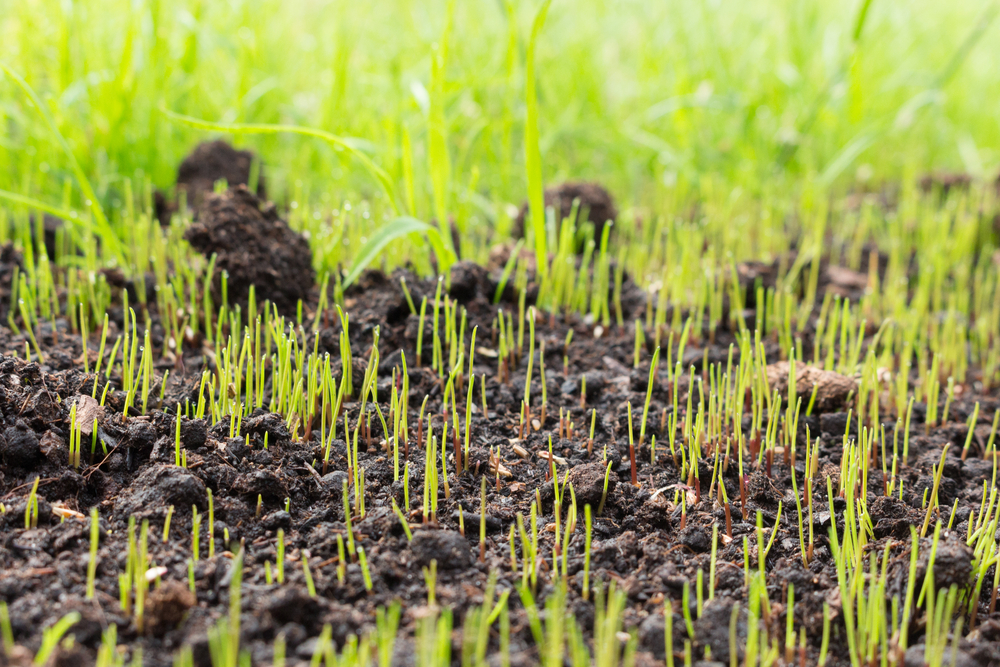
Maintaining a lush, green lawn in Nashville’s unique climate can be a challenge. The city’s hot summers and mild winters, coupled with its fluctuating rainfall, require special attention when it comes to lawn care. At Landscaping Nashville, we understand the importance of proper lawn seeding, which plays a critical role in ensuring a healthy, vibrant lawn all year round.
In this guide, we will cover the best practices for lawn seeding in Nashville, from choosing the right grass type to preparing the soil, and the optimal time to seed. Whether you’re a seasoned homeowner or new to maintaining your yard, this guide is designed to help you achieve the perfect lawn with ease.
CONTACT US
1. Introduction to Nashville Lawn Seeding
For homeowners in Nashville, achieving a well-maintained lawn involves a strategic approach to seeding. The local climate creates both opportunities and challenges for lawn care. Seeding allows you to revitalize your lawn, promote healthy growth, and repair bare or patchy areas. With Landscaping Nashville, you’ll learn how to make the most of Nashville’s growing season, ensuring that your lawn remains strong and beautiful.
2. Why Lawn Seeding is Essential
Lawn seeding, also known as overseeding, is the process of adding new grass seed to an existing lawn or establishing grass on bare soil. This practice is essential for a variety of reasons:
- Revitalization: Over time, lawns can become thin due to wear, weather, and age. Seeding helps replenish the lawn with new grass growth.
- Improved Appearance: A thick, even lawn looks healthy and enhances your home’s curb appeal.
- Disease and Drought Resistance: Introducing new, hardy varieties of grass improves your lawn’s resistance to diseases, pests, and drought conditions, common in Nashville.
With the expert guidance of Landscaping Nashville, you can ensure that your lawn seeding efforts will promote long-term health and beauty.
3. Choosing the Right Grass for Nashville Lawns
One of the most critical steps in lawn seeding is choosing the right type of grass. Nashville falls within the “transition zone,” which means that both cool-season and warm-season grasses can thrive, depending on the care they receive.
Cool-Season Grasses:
- Fescue: Fescue grasses, such as tall fescue and fine fescue, are commonly used in Nashville lawns. They are durable, shade-tolerant, and perform well in cooler temperatures. Fescue is ideal for overseeding in the fall.
Warm-Season Grasses:
- Bermuda Grass: Bermuda grass is a warm-season grass that flourishes in the summer. It’s heat- and drought-tolerant, making it perfect for Nashville’s hot summers. However, it may require more maintenance to keep it from spreading beyond your lawn area.
- Zoysia Grass: Zoysia is another popular warm-season grass, known for its ability to tolerate heavy foot traffic. It’s dense and slow-growing, which can help prevent weeds from taking hold.
Landscaping Nashville recommends a grass type based on your specific lawn conditions, shade levels, and personal preference for lawn texture and color. It’s also worth noting that a mix of both cool- and warm-season grasses can provide year-round coverage.
4. When to Seed in Nashville
Timing your lawn seeding is crucial to achieving successful growth. In Nashville, seeding should be planned based on the type of grass you choose.
Best Time to Seed Cool-Season Grasses:
For cool-season grasses like fescue, the ideal seeding window is in the fall (mid-September to late October). During this time, temperatures are cooler, and there is usually adequate rainfall, promoting healthy root development before winter sets in.
Best Time to Seed Warm-Season Grasses:
For warm-season grasses like Bermuda and Zoysia, seeding should be done in the late spring (April to early June), when soil temperatures consistently stay above 65°F. This ensures that the grass has enough time to establish before the heat of summer.
At Landscaping Nashville, we advise our clients on the best time for lawn seeding based on their grass type and the current weather conditions in the area.
5. How to Prepare Your Soil for Seeding
Healthy soil is the foundation of a successful lawn. Before seeding, it’s essential to prepare the soil to ensure that your grass seeds have the best possible environment for germination.
Steps for Soil Preparation:
- Test Your Soil: A soil test can help determine your soil’s pH levels and identify any nutrient deficiencies. Nashville soils are often clay-heavy, so soil amendments like lime or organic compost may be needed to balance the pH and improve soil structure.
- Aerate the Lawn: Compacted soil can hinder root growth and prevent seeds from taking hold. Core aeration loosens the soil, allowing water, oxygen, and nutrients to penetrate deeper into the ground.
- Clear Debris and Weeds: Remove any leaves, rocks, or weeds from the lawn. Weeds compete with grass seeds for nutrients, so it’s crucial to start with a clean surface.
- Level the Ground: If there are uneven patches, fill them in with topsoil. This will help create a smooth surface for even seed distribution.
At Landscaping Nashville, we offer soil testing, aeration, and debris removal services to prepare your lawn for optimal seeding conditions.
6. Step-by-Step Lawn Seeding Process
Now that your soil is prepared, it’s time to seed. Follow these steps for a successful lawn seeding process:
Step 1: Choose Quality Seeds
Ensure that you purchase high-quality grass seed suited for Nashville’s climate. Look for certified seed that is free from weeds and contaminants.
Step 2: Spread the Seed Evenly
Using a broadcast spreader, distribute the seed evenly across your lawn. Be sure to follow the recommended seed rate on the packaging for your chosen grass type.
Step 3: Lightly Rake the Soil
After spreading the seed, lightly rake the soil to ensure the seeds make good contact with the earth. Avoid raking too deeply, as this could bury the seeds too far below the surface.
Step 4: Apply a Layer of Mulch
Applying a thin layer of straw or mulch helps retain moisture and protect the seeds from birds. This step is particularly important during Nashville’s dry spells.
7. Watering and Fertilizing After Seeding
Proper watering and fertilization after seeding are essential for encouraging germination and root development.
Watering:
For the first few weeks after seeding, keep the soil consistently moist but not waterlogged. Water lightly and frequently, aiming for about 10-15 minutes of watering twice a day. Once the seeds have germinated, reduce the frequency of watering but increase the duration to help the roots grow deeper.
Fertilizing:
About two weeks after seeding, apply a starter fertilizer to provide essential nutrients for young grass. Choose a balanced, slow-release fertilizer to prevent overfeeding and promote steady growth.
Landscaping Nashville offers a full range of post-seeding services, including watering schedules and fertilization plans tailored to your lawn’s specific needs.
8. Common Lawn Seeding Mistakes to Avoid
Even with careful planning, it’s easy to make mistakes during the lawn seeding process. Here are some common pitfalls to avoid:
- Seeding at the Wrong Time: Seeding too early or too late can result in poor germination. Always seed during the optimal growing season for your grass type.
- Overseeding or Underseeding: Applying too much or too little seed can lead to patchy growth. Follow the recommended seeding rate for the best results.
- Neglecting Soil Preparation: Skipping soil preparation can prevent seeds from taking hold. Always aerate, test, and amend your soil as needed before seeding.
- Improper Watering: Both overwatering and underwatering can harm your newly seeded lawn. Be consistent with your watering schedule to keep the soil moist but not soggy.
By avoiding these mistakes, you can set your lawn up for success. If you’re unsure about any part of the process, Landscaping Nashville is here to guide you through every step.
9. Maintaining Your Lawn After Seeding
After your lawn has been successfully seeded, it’s crucial to maintain it properly to ensure long-term health.
Mowing:
Wait until the new grass is at least 3 inches tall before mowing. Make sure your mower blades are sharp to avoid damaging the tender grass.
Aeration and Overseeding:
Even after your lawn is established, annual aeration and overseeding help maintain its thickness and health. In Nashville, it’s recommended to aerate and overseed in the fall for cool-season grasses.
Fertilization:
Feed your lawn with a slow-release fertilizer in the spring and fall to keep it nutrient-rich and healthy.
At Landscaping Nashville, we provide ongoing maintenance services to ensure that your lawn continues to thrive throughout the year.
Frequently Asked Questions (FAQ) about Nashville Lawn Seeding
1. When is the best time to seed my lawn in Nashville?
For cool-season grasses, the best time to seed is in the fall (mid-September to late October). For warm-season grasses, seed in late spring (April to early June).
2. What type of grass is best for Nashville lawns?
Fescue is ideal for cool-season areas, while Bermuda and Zoysia are popular for warm-season lawns. A mix of both can also be beneficial.
3. How do I prepare my soil for seeding?
Test your soil, aerate it, clear any debris, and level uneven patches before seeding.
4. How often should I water newly seeded grass?
Keep the soil consistently moist for the first few weeks, watering lightly 1-2 times a day. Once the grass has germinated, reduce frequency but increase the duration of watering.
5. Should I fertilize after seeding?
Yes, apply a starter fertilizer about two weeks after seeding to provide essential nutrients for healthy growth.
6. What common mistakes should I avoid when seeding my lawn?
Avoid seeding at the wrong time, overseeding or underseeding, neglecting soil preparation, and improper watering.
7. How do I maintain my lawn after seeding?
Mow when the grass reaches 3 inches, aerate and overseed annually, and fertilize in spring and fall to maintain health and thickness.
8. Can I seed over an existing lawn?
Yes, overseeding can help thicken an existing lawn and revitalize areas that are thin or patchy.
10. Conclusion
At Landscaping Nashville, we’re dedicated to helping you achieve the beautiful lawn you’ve always wanted. Whether you have questions about lawn seeding, need expert advice, or want to schedule a consultation, our team is here to assist you. Reach out to us today. You can also fill out our online contact form for a quick response. Let us help you create and maintain a stunning landscape that enhances your home’s curb appeal!

